Deck 15: Conflict and Conquest: the Transformation of the West, 1860-1900
Question
Question
Question
Question
Question
Question
Question
Question
Question
Question
Question
Question
Question
Question
Question
Question
Question
Question
Question
Question
Question
Question
Question
Question
Question
Question
Question
Question
Question
Question
Question
Question
Question
Question
Question
Question
Question
Question
Question
Question
Question
Question
Question
Question
Question
Question
Question
Question
Question
Question
Question

Unlock Deck
Sign up to unlock the cards in this deck!
Unlock Deck
Unlock Deck
1/51
Play
Full screen (f)
Deck 15: Conflict and Conquest: the Transformation of the West, 1860-1900
1
How does John Gast's 1872 painting American Progress reveal the bitter conflict that accompanied the transformation of the West?
A) A cluster of Native Americans and a herd of buffalo flee before the advancing whites.
B) The miners resort to open-pit mining that permanently scarred the landscape.
C) The farmers on the right are dealing with the effects of drought and insect swarms.
D) The mountains in the background symbolize the isolation that Westerners faced.
A) A cluster of Native Americans and a herd of buffalo flee before the advancing whites.
B) The miners resort to open-pit mining that permanently scarred the landscape.
C) The farmers on the right are dealing with the effects of drought and insect swarms.
D) The mountains in the background symbolize the isolation that Westerners faced.
A cluster of Native Americans and a herd of buffalo flee before the advancing whites.
2
Both the Morrill Land Grant College Act and the Pacific Railway Act most directly benefited colleges and railroads through the .
A) publication of promotional literature
B) removal of Indians to reservations
C) federal funding of these institutions
D) sale of public lands
A) publication of promotional literature
B) removal of Indians to reservations
C) federal funding of these institutions
D) sale of public lands
sale of public lands
3
What was one common feature shared by most Native American tribes on the Great Plains?
A) their worship of many gods
B) cultures where peace was glorified over battle
C) a belief that spirits were found in all aspects of nature
D) the lack of communal participation in tribal decision making
A) their worship of many gods
B) cultures where peace was glorified over battle
C) a belief that spirits were found in all aspects of nature
D) the lack of communal participation in tribal decision making
a belief that spirits were found in all aspects of nature
4
The Homestead Act _ .
A) granted land to settlers willing and able to farm the land for five years
B) guaranteed military protection from Indians to Western settlers
C) barred most ex-slaves and other non-whites from Western settlement
D) denied land to Eastern speculators and corporations
A) granted land to settlers willing and able to farm the land for five years
B) guaranteed military protection from Indians to Western settlers
C) barred most ex-slaves and other non-whites from Western settlement
D) denied land to Eastern speculators and corporations

Unlock Deck
Unlock for access to all 51 flashcards in this deck.
Unlock Deck
k this deck
5
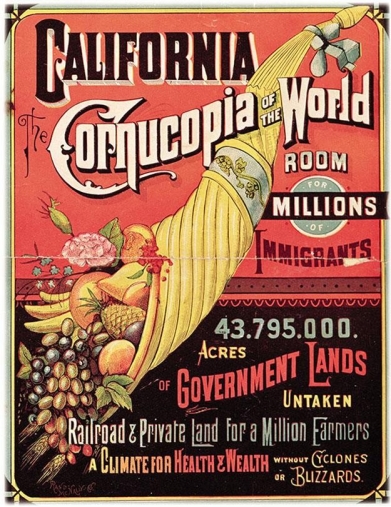
What made the content of the 1883 railroad promotional poster "California, Cornucopia of the World" ironic?
A) The poster advertised a healthy climate, yet California experienced severe epidemics during this time.
B) The poster welcomed immigrants, yet California successfully lobbied Congress to bar Chinese immigration.
C) The land promoted in this poster had been illegally acquired by the railroad from the federal government.
D) The weather in California was actually more conducive to cyclones and blizzards than it was in the Great Plains.

Unlock Deck
Unlock for access to all 51 flashcards in this deck.
Unlock Deck
k this deck
6
How did the Supreme Court 1876 cases of Munn v. Illinois and Peik v. Chicago and Northwestern Railway affect the economic development of the West?
A) They implemented limitations on the power and profits made by railroads on interstate trade.
B) They banned the unregulated open-pit mining system that damaged the environment.
C) They illegalized the practice used by mining corporations to integrate their resources with the means and methods of production.
D) They refused to let creditors charge high interest rates for farm loans.
A) They implemented limitations on the power and profits made by railroads on interstate trade.
B) They banned the unregulated open-pit mining system that damaged the environment.
C) They illegalized the practice used by mining corporations to integrate their resources with the means and methods of production.
D) They refused to let creditors charge high interest rates for farm loans.

Unlock Deck
Unlock for access to all 51 flashcards in this deck.
Unlock Deck
k this deck
7
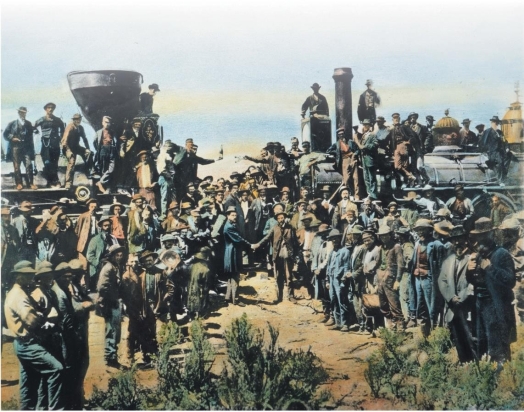
This 1869 iconic photograph that shows the completion of the transcontinental railroad in Promontory Point, Utah, is notable for its exclusion of the .
A) women who ran the camps where laborers resided
B) Chinese laborers who helped build it
C) gold-rush millionaires who paid for it
D) Union Pacific and Central Pacific officials

Unlock Deck
Unlock for access to all 51 flashcards in this deck.
Unlock Deck
k this deck
8
What was one significant flaw of the Homestead Act, particularly in more arid areas of the West?
A) Grasshopper plagues and other swarms of insects destroyed crops.
B) 160-acre allotments were too small for profitable farming.
C) Farmers and homesteaders had few opportunities for social interactions.
D) Railroads set exorbitant rates to ship farmers' products to market.
A) Grasshopper plagues and other swarms of insects destroyed crops.
B) 160-acre allotments were too small for profitable farming.
C) Farmers and homesteaders had few opportunities for social interactions.
D) Railroads set exorbitant rates to ship farmers' products to market.

Unlock Deck
Unlock for access to all 51 flashcards in this deck.
Unlock Deck
k this deck
9
How did the railroad benefit Western farmers most?
A) It gave them access to manufactured goods.
B) It provided an escape from their isolation.
C) It provided employment during the off-season.
D) It enabled them to get their products to market.
A) It gave them access to manufactured goods.
B) It provided an escape from their isolation.
C) It provided employment during the off-season.
D) It enabled them to get their products to market.

Unlock Deck
Unlock for access to all 51 flashcards in this deck.
Unlock Deck
k this deck
10
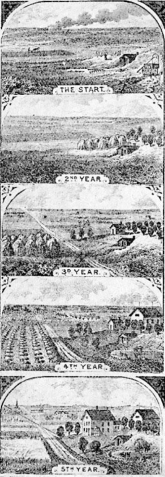
What was the intention of this inaccurate advertisement that the B. and M. Railroad published in a Czech language magazine?
A) The advertisement implied that settling land in the Great Plains would be a difficult process.
B) The advertisement warned that settling the Great Plains would not offer all of the blessings of civilization.
C) The advertisement guaranteed that settlers who moved to the Great Plains would achieve rapid success.
D) The advertisement advised settlers that they would need to implement current technological advances to farm the Great Plains.

Unlock Deck
Unlock for access to all 51 flashcards in this deck.
Unlock Deck
k this deck
11

What does this photograph of the four Chrisman sisters standing in front of their sod home in Custer County, Nebraska, reveal about life on the Great Plains?
A) Homesteading was often accompanied by the challenges of loneliness and drudgery.
B) Sod homes and dugouts offered basic amenities like running water and glass windows.
C) Single women were often more successful at homesteading than single men or families.
D) Farming on homesteads was profitable because of mild weather conditions and fertile soil.

Unlock Deck
Unlock for access to all 51 flashcards in this deck.
Unlock Deck
k this deck
12

How did this image from Harper's Weekly capture the hope that many Exodusters expressed as they moved west from the Deep South to Kansas?
A) Emancipation gave them the freedom to move to a "promised land" in the West.
B) Manifest Destiny instilled a belief in them that God sanctioned their right to own land in the West.
C) They were grateful for the wealth they accumulated that allowed them to establish new farms.
D) They understood that traveling in groups was safer than traveling alone when moving west.

Unlock Deck
Unlock for access to all 51 flashcards in this deck.
Unlock Deck
k this deck
13
Why did the Mormons under the leadership of Brigham Young migrate west to Utah?
A) The Great Salt Lake provided them with plentiful access to fresh water.
B) They were welcomed by the local Indians to settle there.
C) They were searching for an isolated place where they could ensure security and survival.
D) They desired to purchase inexpensive and fertile farmlands.
A) The Great Salt Lake provided them with plentiful access to fresh water.
B) They were welcomed by the local Indians to settle there.
C) They were searching for an isolated place where they could ensure security and survival.
D) They desired to purchase inexpensive and fertile farmlands.

Unlock Deck
Unlock for access to all 51 flashcards in this deck.
Unlock Deck
k this deck
14
What factor made the Navajo more migratory after initial contact with the Spanish?
A) conversion to Christianity
B) the introduction of horses and sheep
C) exposure to fatal diseases
D) warfare with the Spanish
A) conversion to Christianity
B) the introduction of horses and sheep
C) exposure to fatal diseases
D) warfare with the Spanish

Unlock Deck
Unlock for access to all 51 flashcards in this deck.
Unlock Deck
k this deck
15
What caused hardships for wheat farmers on the Great Plains in the 1880s?
A) a sudden spike in the price of wheat
B) rising interest rates for bank loans
C) agricultural competition from foreign nations
D) the dwindling supply of available homesteads
A) a sudden spike in the price of wheat
B) rising interest rates for bank loans
C) agricultural competition from foreign nations
D) the dwindling supply of available homesteads

Unlock Deck
Unlock for access to all 51 flashcards in this deck.
Unlock Deck
k this deck
16
How did Oliver H. Kelley contribute to the economic development of the West?
A) He invented barbed wire, which closed off the open range to large cattle drives.
B) He led the first Long Drive from Texas to Kansas that resulted in a booming beef industry.
C) He developed the process of open-pit mining that permanently scarred the landscape.
D) He organized the Grange, which created laws to protect farmers' economic interests.
A) He invented barbed wire, which closed off the open range to large cattle drives.
B) He led the first Long Drive from Texas to Kansas that resulted in a booming beef industry.
C) He developed the process of open-pit mining that permanently scarred the landscape.
D) He organized the Grange, which created laws to protect farmers' economic interests.

Unlock Deck
Unlock for access to all 51 flashcards in this deck.
Unlock Deck
k this deck
17
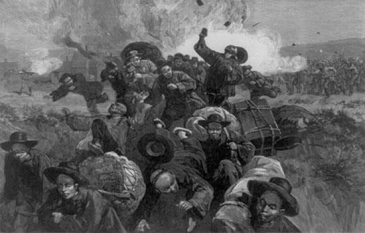
What motivated whites to attack and kill 28 Chinese miners in Rock Springs, Wyoming, as shown in this 1885 drawing from Harper's Weekly?
A) Whites feared that the Chinese population in the West would be larger than their own.
B) Whites suspected the Chinese of plotting a violent overthrow of local authorities.
C) The Chinese had been taking over the claims that white prospectors had on local mines.
D) The Chinese were perceived as a job threat and responsible for lowering wages.

Unlock Deck
Unlock for access to all 51 flashcards in this deck.
Unlock Deck
k this deck
18
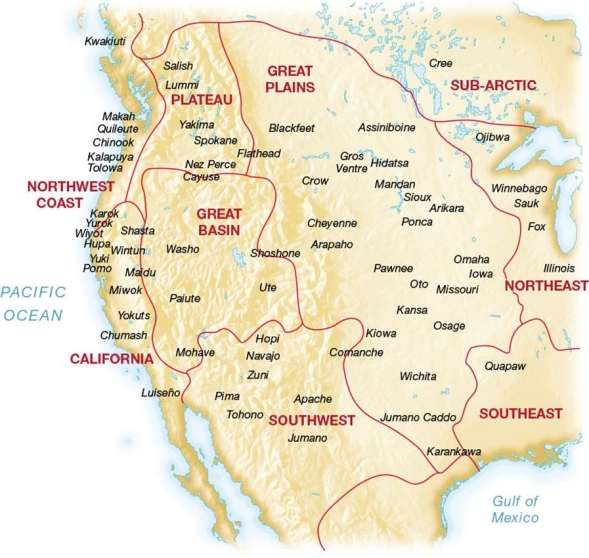
What generalization can be made about the Native American tribes who lived in the Trans- Mississippi West?
A) Geographic isolation resulted in a lack of contact with Euro-American groups until the early nineteenth century.
B) Most tribes were migratory and traveled through different geographic regions.
C) Geography divided them into diverse culture groups who adapted to different natural environments.
D) Most tribes had been forcibly relocated to this region by the American government.

Unlock Deck
Unlock for access to all 51 flashcards in this deck.
Unlock Deck
k this deck
19
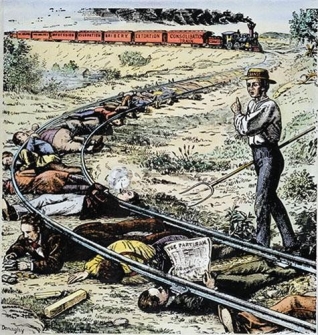
How did "Granger Laws" address the railroad corruption depicted in this 1873 cartoon?
A) They allowed railroads the power to offer preferred customers special rates.
B) They ruled that state legislatures could regulate interstate railroad commerce.
C) They set maximum rates for transporting or storing grain by railroads.
D) They forced railroads to turn over lands adjacent to tracks to homesteaders.

Unlock Deck
Unlock for access to all 51 flashcards in this deck.
Unlock Deck
k this deck
20

What did artist George Catlin imply about the Plains Indians through his 1844 painting Buffalo Chase over Prairie Bluffs?
A) The Plains Indians remained in relative isolation up through the early nineteenth century.
B) Horsemanship and buffalo hunts were activities that Plains Indians could do with relatively little skill.
C) Migratory Plains tribes were inferior to the sedentary ones and resorted to hunting buffalo in order to survive.
D) The advantages of the horse and buffalo made migratory tribes the dominant powers on the Great Plains.

Unlock Deck
Unlock for access to all 51 flashcards in this deck.
Unlock Deck
k this deck
21
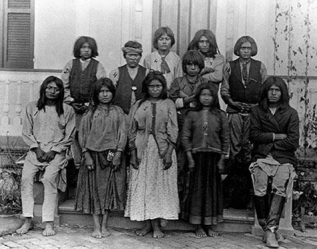
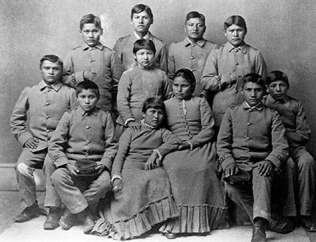
What did these 1890s before-and-after photographs of Chiricahua Apache children at the Carlisle Boarding School in Pennsylvania reveal about the expectations for Native Americans under the Dawes Severalty Act?
A) Supporters of the boarding school program opposed the trauma and "cultural genocide" that resulted from boarding school education.
B) Maintaining traditional customs and culture was essential when educating Native Americans.
C) Native Americans were more successful if they received reservation-based education.
D) Complete assimilation was the only way for Native Americans to survive in the United States.

Unlock Deck
Unlock for access to all 51 flashcards in this deck.
Unlock Deck
k this deck
22
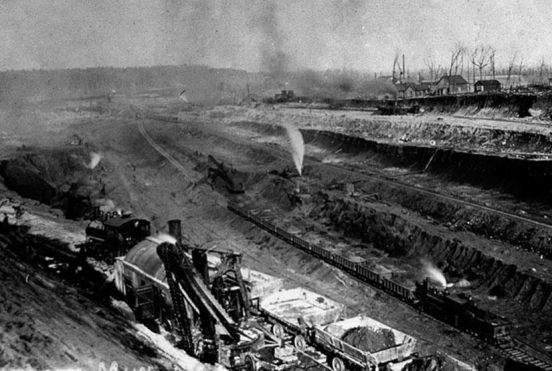
Why was the mining industry able to use environmentally harmful methods such as open-pit mining in places like Minnesota's Mesabi Range as illustrated in this photograph?
A) The harmful effects of open-pit mining were limited to minimal scarring on the landscape.
B) An environmental movement had not yet been created in the United States.
C) Western states did not have the political power to regulate the mining industry.
D) Political officials in the West received kickbacks and bribes from the mining industry.

Unlock Deck
Unlock for access to all 51 flashcards in this deck.
Unlock Deck
k this deck
23
What incident led Nez Perce Chief Joseph to comment "My heart is sick and sad. From where the sun now stands, I will fight no more forever"?
A) Custer's defeat at Little Big Horn
B) the massacre at Sand Creek
C) the forced surrender of his people just before they reached Canada
D) Sitting Bull's murder at the Pine Ridge Reservation
A) Custer's defeat at Little Big Horn
B) the massacre at Sand Creek
C) the forced surrender of his people just before they reached Canada
D) Sitting Bull's murder at the Pine Ridge Reservation

Unlock Deck
Unlock for access to all 51 flashcards in this deck.
Unlock Deck
k this deck
24
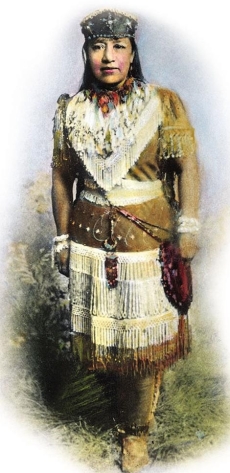
What conclusion can be made about why Paiute Indian reformer Sarah Winnemucca wore this type of outfit on her speaking tours?
A) She wanted to highlight the harmful effects of assimilation on Native Americans.
B) She wanted to show people what traditional Paiute clothing and jewelry looked like.
C) She wanted to draw attention to her lectures on the plight of Native American women.
D) She wanted to make the public aware that she was a true "Indian princess" like Pocahontas.

Unlock Deck
Unlock for access to all 51 flashcards in this deck.
Unlock Deck
k this deck
25
How did the introduction of foreign plants and animals alter the Western environment?
A) A lack of predators allowed them to spread rapidly and disrupt the ecosystem.
B) Many of the new animal species decimated the native buffalo population.
C) The introduction of cheatgrass from Asia harmed livestock that grazed on it.
D) New water plants choked and poisoned river systems.
A) A lack of predators allowed them to spread rapidly and disrupt the ecosystem.
B) Many of the new animal species decimated the native buffalo population.
C) The introduction of cheatgrass from Asia harmed livestock that grazed on it.
D) New water plants choked and poisoned river systems.

Unlock Deck
Unlock for access to all 51 flashcards in this deck.
Unlock Deck
k this deck
26
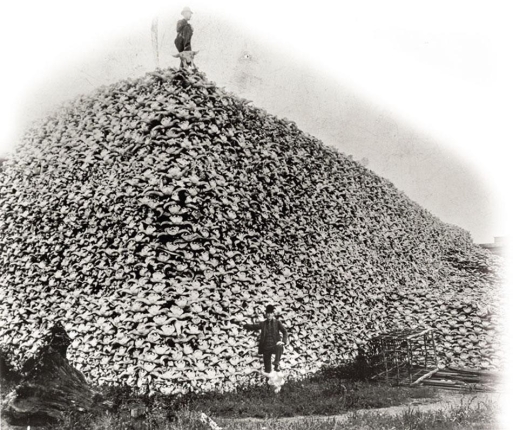
What was the primary reason during the 1870s and 1880s for the staggering extermination of the buffalo, which reduced their population by nearly three million and resulted in massive piles of skulls sent to fertilizer plants?
A) preventing disruption to incoming trains
B) forcing the Plains Indians to become dependent on reservations
C) supplying the East with fashionable buffalo robes
D) organizing elaborate hunting parties for Eastern and European social elites

Unlock Deck
Unlock for access to all 51 flashcards in this deck.
Unlock Deck
k this deck
27
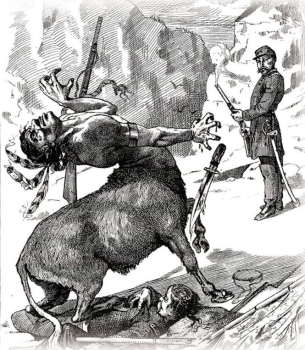
How did this cartoon, which was published in the New York Graphic shortly after Custer's defeat at the Battle of Little Big Horn in 1876, depict American Indians like Sitting Bull?
A) as close allies of the federal military
B) as wretched figures dispossessed of their lands
C) as noble warriors who stood up to Custer's cavalry
D) as subhuman savages to be disposed of

Unlock Deck
Unlock for access to all 51 flashcards in this deck.
Unlock Deck
k this deck
28
What did Sitting Bull mean when he stated in his 1877 speech at the Powder River Council that "…we were assured that the buffalo country should be left to us forever. Now they [whites] threaten to take that from us also…"?
A) Railroad companies and entrepreneurs virtually eliminated the buffalo from the Great Plains.
B) The federal government violated treaties declaring Indian lands off limits to white settlement.
C) The defacement of the earth made by farmers and miners was sacrilegious.
D) The encroaching white culture was more civilized than the Sioux culture.
A) Railroad companies and entrepreneurs virtually eliminated the buffalo from the Great Plains.
B) The federal government violated treaties declaring Indian lands off limits to white settlement.
C) The defacement of the earth made by farmers and miners was sacrilegious.
D) The encroaching white culture was more civilized than the Sioux culture.

Unlock Deck
Unlock for access to all 51 flashcards in this deck.
Unlock Deck
k this deck
29
What made the 1864 Sand Creek Massacre in Colorado so atrocious?
A) Most of the victims were defenseless Cheyenne women and children whose bodies were scalped and mutilated.
B) Federal agents intentionally gave the Cheyenne tribe blankets infected with smallpox, which led to many deaths in a short amount of time.
C) Over 800 Cheyenne men were gunned down while they were hunting buffalo.
D) Colonel John M. Chivington's entire military force was ambushed and killed by Cheyenne warriors.
A) Most of the victims were defenseless Cheyenne women and children whose bodies were scalped and mutilated.
B) Federal agents intentionally gave the Cheyenne tribe blankets infected with smallpox, which led to many deaths in a short amount of time.
C) Over 800 Cheyenne men were gunned down while they were hunting buffalo.
D) Colonel John M. Chivington's entire military force was ambushed and killed by Cheyenne warriors.

Unlock Deck
Unlock for access to all 51 flashcards in this deck.
Unlock Deck
k this deck
30
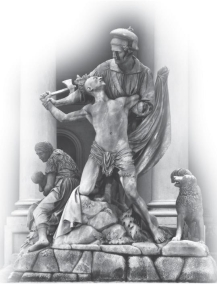
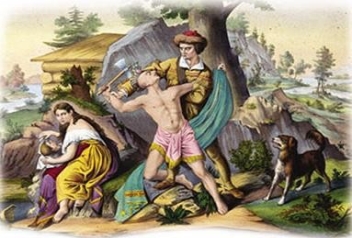
What key message did Horatio Greenough's 1853 sculpture The Rescue and the 1874 dime novel cover for a Daniel Boone story, which used Greenough's sculpture as the basis for its artwork, send to the American public?
A) Both images showed that life on the frontier was unsuitable for women and children.
B) Both images depicted the Indian as a noble savage.
C) Both images proclaimed Indian savagery and justified white supremacy.
D) Both images illustrated how the warrior dominated the frontiersman.

Unlock Deck
Unlock for access to all 51 flashcards in this deck.
Unlock Deck
k this deck
31
The main goal of the Dawes Severalty Act toward Native Americans was .
A) extermination
B) assimilation
C) land redistribution
D) vocational training
A) extermination
B) assimilation
C) land redistribution
D) vocational training

Unlock Deck
Unlock for access to all 51 flashcards in this deck.
Unlock Deck
k this deck
32
Where did cattle ranching and cattle drives originate?
A) Colorado
B) Kansas
C) California
D) Texas
A) Colorado
B) Kansas
C) California
D) Texas

Unlock Deck
Unlock for access to all 51 flashcards in this deck.
Unlock Deck
k this deck
33
Although both Helen Hunt Jackson and Sarah Winnemucca were proponents of education for Native American children, how did their views differ?
A) Jackson believed that they should be assimilated, while Winnemucca believed they should retain their culture and traditions.
B) Jackson believed they should keep their culture, while Winnemucca believed they should be assimilated.
C) Jackson believed they should learn on their own reservations, while Winnemucca called for their relocation to boarding schools in the East.
D) Jackson believed they should receive formal education in the humanities, while Winnemucca believed they would be more successful with vocational training.
A) Jackson believed that they should be assimilated, while Winnemucca believed they should retain their culture and traditions.
B) Jackson believed they should keep their culture, while Winnemucca believed they should be assimilated.
C) Jackson believed they should learn on their own reservations, while Winnemucca called for their relocation to boarding schools in the East.
D) Jackson believed they should receive formal education in the humanities, while Winnemucca believed they would be more successful with vocational training.

Unlock Deck
Unlock for access to all 51 flashcards in this deck.
Unlock Deck
k this deck
34
The second Fort Laramie Treaty was violated when .
A) the Sioux attempted to extend their hunting grounds
B) gold was discovered in the Black Hills
C) Red Cloud's War broke out
D) Indian warriors attacked the forces of Lieutenant Colonel George Custer
A) the Sioux attempted to extend their hunting grounds
B) gold was discovered in the Black Hills
C) Red Cloud's War broke out
D) Indian warriors attacked the forces of Lieutenant Colonel George Custer

Unlock Deck
Unlock for access to all 51 flashcards in this deck.
Unlock Deck
k this deck
35
In addition to epidemics of smallpox and measles, what other factor introduced by Euro- Americans compromised the health of many Native Americans?
A) alcohol
B) new vegetables and fruits
C) local water polluted by the mining industry
D) the consumption of beef and mutton
A) alcohol
B) new vegetables and fruits
C) local water polluted by the mining industry
D) the consumption of beef and mutton

Unlock Deck
Unlock for access to all 51 flashcards in this deck.
Unlock Deck
k this deck
36
What made Virginia City, Nevada, a boomtown in the 1870s?
A) the influx of Texas cattle brought on the Long Drives
B) the discovery of the Big Bonanza, the largest silver vein ever found
C) the arrival of the Central Pacific Railroad from California
D) the allocation of public lands through the Homestead Act
A) the influx of Texas cattle brought on the Long Drives
B) the discovery of the Big Bonanza, the largest silver vein ever found
C) the arrival of the Central Pacific Railroad from California
D) the allocation of public lands through the Homestead Act

Unlock Deck
Unlock for access to all 51 flashcards in this deck.
Unlock Deck
k this deck
37
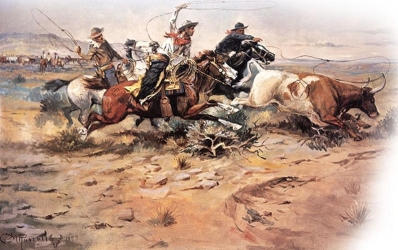
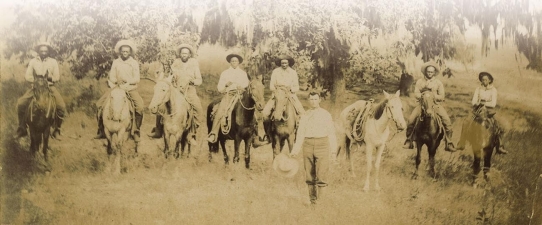
How does the top photograph of Texas cowboys in the 1880s refute the image of cowboy life that Charles Russell portrayed in his 1897 painting The Herd Quitters?
A) Cowboy work was unexciting and filled with drudgery.
B) Cowboys came from many racial and ethnic backgrounds.
C) Cowboys herded cattle in various geographical environments, not just the open plains.
D) Cowboy attire was often more flamboyant than what Russell's painting depicts.

Unlock Deck
Unlock for access to all 51 flashcards in this deck.
Unlock Deck
k this deck
38
What did Englishman William Blackmore imply when he stated that "all authorities…are unanimous in predicting that the Red Men are a doomed race," in his introduction to The Plains of the Great West and Their Inhabitants?
A) The lack of immunity to many diseases ensured the extinction of American Indians.
B) The extermination of the buffalo would lead to the starvation of many Native Americans.
C) Whites were willing to assimilate American Indians into their society.
D) White progress through Manifest Destiny would eliminate American Indians.
A) The lack of immunity to many diseases ensured the extinction of American Indians.
B) The extermination of the buffalo would lead to the starvation of many Native Americans.
C) Whites were willing to assimilate American Indians into their society.
D) White progress through Manifest Destiny would eliminate American Indians.

Unlock Deck
Unlock for access to all 51 flashcards in this deck.
Unlock Deck
k this deck
39

How did this 1911 advertisement for the sale of Indian reservation lands reflect the hypocrisy and flaws of the Dawes Severalty Act?
A) The reservation lands put up for sale were of higher quality than those set aside for Native American heads of households.
B) The reservation lands sold were at less expensive rates than those sold to Native American heads of households.
C) White buyers had an easier time acquiring titles to former reservation lands than Native Americans did for their legally allotted lands.
D) White buyers were encouraged to farm these lands while Native Americans were discouraged from doing so.

Unlock Deck
Unlock for access to all 51 flashcards in this deck.
Unlock Deck
k this deck
40
Many of the traditions associated with American cowboys originated with the .
A) Native Americans
B) African Americans
C) Irish
D) Mexicans and Spanish
A) Native Americans
B) African Americans
C) Irish
D) Mexicans and Spanish

Unlock Deck
Unlock for access to all 51 flashcards in this deck.
Unlock Deck
k this deck
41
Which topic is likely to be stressed by a New Western historian such as Patricia Nelson Limerick in her 1987 book The Legacy of Conquest: The Unbroken Past of the American West?
A) the traditional frontier heroes
B) the savagery of Native Americans
C) the settlers' triumphs over obstacles in the West
D) the diversity of the West
A) the traditional frontier heroes
B) the savagery of Native Americans
C) the settlers' triumphs over obstacles in the West
D) the diversity of the West

Unlock Deck
Unlock for access to all 51 flashcards in this deck.
Unlock Deck
k this deck
42
According to his Frontier Thesis, Frederick Jackson Turner proposed that the western frontier
A) contributed to the creation of a classless society
B) discouraged individualism and innovation
C) fostered a value for democracy
D) closed in the year 1900
A) contributed to the creation of a classless society
B) discouraged individualism and innovation
C) fostered a value for democracy
D) closed in the year 1900

Unlock Deck
Unlock for access to all 51 flashcards in this deck.
Unlock Deck
k this deck
43
In the 1990s, the site of the Battle of Little Bighorn in Montana .
A) was closed to the public after it was occupied by a Native American rights movement
B) had its name changed to reflect the participation of Native American warriors
C) was dedicated as a monument to Custer and the Seventh Cavalry
D) became the location for a mountain-carved image of Chief Crazy Horse
A) was closed to the public after it was occupied by a Native American rights movement
B) had its name changed to reflect the participation of Native American warriors
C) was dedicated as a monument to Custer and the Seventh Cavalry
D) became the location for a mountain-carved image of Chief Crazy Horse

Unlock Deck
Unlock for access to all 51 flashcards in this deck.
Unlock Deck
k this deck
44
How do films that were made after 1990, such as Dances with Wolves and Unforgiven,
Represent the American West?
A) They focus on a revisionist view that depicts Native Americans with sympathy and the West as a hostile place.
B) They continue to portray Native Americans as insignificant contributors to the development of the West.
C) They accurately address the ideas found in Frederick Jackson Turner's Frontier Thesis.
D) They revive the traditional themes of 1940s and 1950s Westerns that featured heroic cowboys and hostile Indians.
Represent the American West?
A) They focus on a revisionist view that depicts Native Americans with sympathy and the West as a hostile place.
B) They continue to portray Native Americans as insignificant contributors to the development of the West.
C) They accurately address the ideas found in Frederick Jackson Turner's Frontier Thesis.
D) They revive the traditional themes of 1940s and 1950s Westerns that featured heroic cowboys and hostile Indians.

Unlock Deck
Unlock for access to all 51 flashcards in this deck.
Unlock Deck
k this deck
45
What made "Buffalo Bill's Wild West" so popular with the American public?
A) It seemed to give Americans a way to experience the West.
B) It focused on nature's devastation in the West.
C) It provided an accurate representation of the West.
D) It hired a series of famous actors to portray Sitting Bull.
A) It seemed to give Americans a way to experience the West.
B) It focused on nature's devastation in the West.
C) It provided an accurate representation of the West.
D) It hired a series of famous actors to portray Sitting Bull.

Unlock Deck
Unlock for access to all 51 flashcards in this deck.
Unlock Deck
k this deck
46
The Ghost Dancers alarmed federal officials because of their .
A) connections to their ancestral spirits
B) accumulation of large stores of weapons
C) potential to foster rebellion
D) messages of wrath and revenge
A) connections to their ancestral spirits
B) accumulation of large stores of weapons
C) potential to foster rebellion
D) messages of wrath and revenge

Unlock Deck
Unlock for access to all 51 flashcards in this deck.
Unlock Deck
k this deck
47
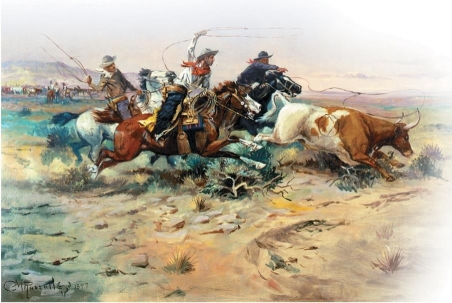
Charles Russell's painting The Herd Quitters could best be viewed as symbolizing what view of the West?
A) a place of unity among peoples
B) a place of heroism, daring, and manly individualism
C) a land where humans lived in harmony with nature
D) a land of lawlessness and brutality

Unlock Deck
Unlock for access to all 51 flashcards in this deck.
Unlock Deck
k this deck
48
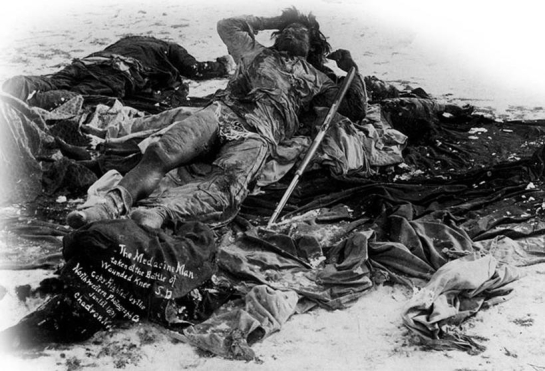
How did the photographer manipulate the image "The Medicine Man Taken at Wounded Knee, S.D."?
A) Only the bodies of two Indians were photographed to show that Wounded Knee was not a brutal massacre by white soldiers.
B) A soldier placed the rifle on the medicine man so the photographer could present an image of a hostile Indian.
C) The medicine man's body was laid out in this Christ-like pose to show that he was a noble warrior.
D) The photographer dressed the medicine man in this costume to demonstrate that Indians had not assimilated into American society.

Unlock Deck
Unlock for access to all 51 flashcards in this deck.
Unlock Deck
k this deck
49
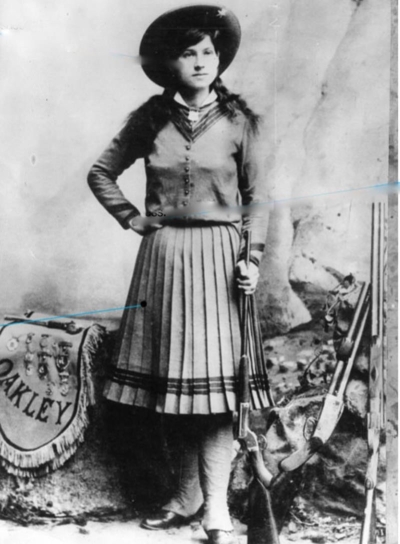
As seen in this photograph, Annie Oakley was typically portrayed as .
A) a strong woman bent on challenging traditional gender roles
B) a performer whose apparent skill was probably fake
C) upholding Victorian mores and values
D) combining feminine beauty with masculine strength

Unlock Deck
Unlock for access to all 51 flashcards in this deck.
Unlock Deck
k this deck
50
Mark Twain's novels were marked by their celebration of .
A) the cowboy and cattle drives
B) adventure and individualism
C) Native American culture
D) the lives of Western miners
A) the cowboy and cattle drives
B) adventure and individualism
C) Native American culture
D) the lives of Western miners

Unlock Deck
Unlock for access to all 51 flashcards in this deck.
Unlock Deck
k this deck
51
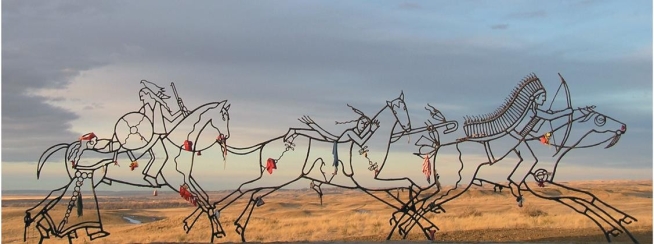
This 2003 monument commemorating the Native Americans who fell at the Battle of Little Bighorn celebrates the unity of the Sioux, Cheyenne, and Arapaho warriors even as it symbolically portrays .
A) their savagery in war
B) how Americans relied on an incomplete and overly simplistic understanding of the West
C) the loss of their culture
D) the environmental destruction of their native lands

Unlock Deck
Unlock for access to all 51 flashcards in this deck.
Unlock Deck
k this deck



